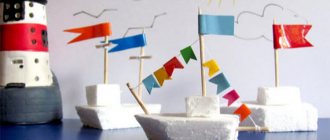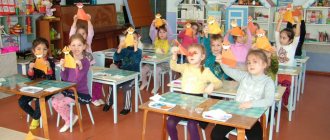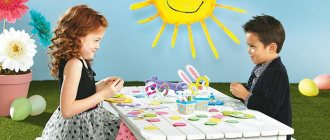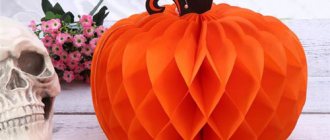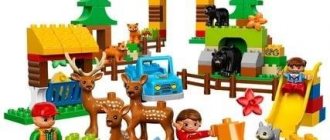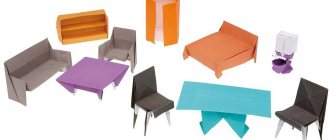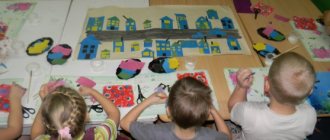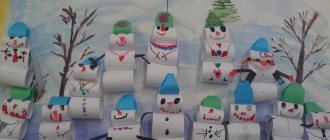Interesting ideas and design schemes
For older preschoolers, the greatest pleasure comes from activities that contain a play element. To maintain interest in paper design among students, it is necessary to select unusual topics for classes, use a game form of learning, and select objects for design that will be suitable for children’s play activities.
Photo gallery: templates for paper construction
Sample
Sample
Sample
Sample
Sample
Sample
Sample
Sample
Sample
Photo gallery: examples of ready-made paper crafts
Example of design from paper Example of design from paper Example of design from paper Example of design from paper with additional drawing according to plan
An example of a paper design using the origami technique (applique)
An example of a paper design using pasta to complete the design
An example of designing from paper using the origami technique and simple drawing. An example of designing from paper. An example of designing from paper. Using crafts in the game
Options for completing the task
Example of paper construction
Example of paper construction
Example of paper construction
Example of paper construction
Example of paper construction
Example of paper construction Example of paper construction
An example of a paper design using the origami technique
An example of designing from paper using drawing techniques An example of designing from paper using drawing techniques
Video: paper construction lesson on the theme “Gift for Dad”
Video: paper art design in kindergarten
Video: open lesson on paper construction on the theme “Aquarium”
Video: paper construction on the theme “Year of the Rooster”
Eagle
First you need to pluck the lump using pliers. These types of crafts for moms and dads in the older group may not be easy, so it's just worth trying again if it doesn't work out.
The body of the bird itself can be made from plasticine or using the methods indicated above in the instructions for the golden birds.
As a base, you can use ordinary thick cardboard or a plastic base, or prepare a real piece of driftwood or a wooden block.
You can take a plastic bottle, fill it with something heavy, like sand, and decorate it to look like wood. Attach the body of the eagle on top.
In the direction from the tail, glue the scales from the pine cone onto superglue or hot nails.
Crafts for kids: ideas on how to make cool crafts with your own hands (125 photos and videos)- Crafts for boys: 130 photos of original and beautiful options for creating stylish and beautiful crafts
Plasticine crafts for children - video + 135 photos of beautiful options for creating original crafts
Instead of a feather cone, you can use seed shells.
Senior group. Senior preschool age. Children 5-6 years old
Children's master class on paper applique “Snowman” for children from 5 years old
This master class will be interesting and useful for children from 5 years old, educators, and parents for joint creativity with their children. Children will learn how to fold and cut out snowflakes and create an interesting image of a snowman based on them. After all, snowmen are children's favorite winter characters...
Master class “New Year's toy “Snowman” made of paper for children 5–6 years old
Master class New Year's toy “Snowman” Author: Agafonova Ekaterina Vasilievna, teacher of the MADOU kindergarten No. 51 in Tyumen. Description: The master class is intended for children 5-6 years old, preschool teachers, additional education teachers, primary teachers...
Shark from plates
To do such crafts with older children, you can purchase disposable paper plates of the desired color or paint them. Plastic ones can also be used, and if you need to paint, use gouache mixed with soap.
Cut out a sector from a plate and glue teeth from this piece or paper to create a toothy mouth.
Partially paint the body blue and leave the belly white. Glue the paper tail and fin to the back.
Eyes can be drawn or glued.
Children's master class on constructing a “Funny traffic light” in the preparatory group
Pismennaya Elena
Children's master class on designing a “Funny Traffic Light” in the preparatory group
Program objectives: To develop children’s ability to make a traffic light on a stand , to consolidate silhouette cutting techniques, twisting and twisting techniques, to consolidate the ability to transform flat material into a three-dimensional form, using different materials for creativity (cardboard, paper, napkins, wax pencils)
;
clarify traffic rules, meaning and colors of traffic lights , develop imagination and creativity;
cultivate perseverance. I wonder when and how the first traffic light ? The first traffic light appeared in London about 140 years ago. The traffic light stood in the center of the city on a pole 6 meters high. It was controlled by a specially assigned person. Using a belt system, he raised and lowered the instrument needle. Then the arrow was replaced by a lantern that ran on lamp gas . The lantern had green and red glass.
The first electric traffic light appeared in the USA in 1914. It also had two signals - red and green - and was controlled manually. The yellow signal replaced the police warning whistle. traffic lights appeared in New York .
In our country, the first traffic light appeared in 1929 in Moscow. It looked like a round clock with three sectors - red, yellow and green. And the adjuster manually turned the arrow, setting it to the desired color. traffic lights with three sections of the modern type appeared in Moscow and Leningrad And in 1937, the first pedestrian traffic light .
For the master class you will need white and brown cardboard, white paper, napkins (red, yellow, green), black wax pencil, scissors, glue, a simple pencil, a traffic light , a round block.
First, white cardboard was tinted black. To do this, white cardboard was painted with the side of a black wax pencil.
We took a traffic light stencil , outlined it and cut it out .
A round block was outlined on a white sheet of paper, cut out and glued to the future traffic light .
We take napkins, tear them into strips and press them into flagella. We glue the flagella onto the circle in a circle. This results in three colors of traffic lights .
a traffic light from brown cardboard . Fold a strip of cardboard 5 centimeters wide in half and cut it.
a traffic light on the stand .
Children's master class on crafts made from cotton pads with elements of modeling and drawing "Our friend traffic light" in the younger group CHILDREN'S MASTER - CLASS FROM COTTON PADS WITH ELEMENTS OF MODELING AND DRAWING "OUR FRIEND TRAFFIC LIGHT" IN THE YOUNGER GROUP Goal: - To teach children.Summary of a lesson on manual labor in the senior group on the topic “Kittens.”
One two three four five!
Come visit us guys
Look and count.
(S. Mikhalkov).
- Look how happy she is. After all, little kittens feel warm and comfortable next to their mother cat.
Sad music is playing.
- Guys, it seemed to me that someone meowed pitifully on your tables. Turn over your sheets of paper and see who it is? (Cat Mom).
- Why do you think your cats are sad? (Their little kittens are lost, they are not with their mother cat).
- Let's help cat mothers find their little kittens and construct little kitten faces out of paper.
- Look how I do it. (Showing methods of action).
— We will construct the kittens’ faces from a square. You have squares of different colors on your trays, so you will get kittens of different colors: one is white, the other is brown...
- Look how I make the face of a ginger kitten.
— I’ll bend the square in half with a “scarf.”
— I will bend the resulting triangle in half. I'll unfold it.
This is how we marked the middle of the triangle.
— I raise the corners from the middle of the long side, but do not bring them to the top of the upper corner. These are our ears.
— I raise the bottom corner a little up.
— I’ll bend the side corners a little bit towards the center line. Turn the workpiece over. I'll lower the top corner a little.
— It turned out to be the face of a kitten.
— If you bend the upper corner in the other direction, the muzzle will turn out a little different. Here it is. Anyone who wants to do it this way will also be fine. Using felt-tip pens I draw in the eyes, nose, mouth and mustache and my kitten becomes as if alive. To make the work neat, I will smear the cat’s face with glue on the back side, put a little glue on the brush, and remove the excess glue on the edges of the jar. I glue my kitten to my mother cat. I remove excess glue with a cloth. Look, he is also hidden in her fluffy fur, so that only one head is visible. And I'll call him Shustrik.
Consolidation.
- What will you do? (kitten faces).
—Where will you start working? (let's bend the square into a scarf).
— How do we mark the middle of the triangle? (let's bend it in half).
- What then? (Raise the corners, from the middle of the long side without bringing them to the top of the upper corner).
-Where should we bend the side corners? (slightly towards the midline).
- What then? (Turn the craft over and lower the top corner).
- How else can you bend the top corner? (Without turning the craft over, immediately the corner is down).
- Where can we put glue on the face? How?
-Where should we stick it?
— What needs to be done to make the kitten “come to life”? (complete the nose, eyes, mouth, mustache).
— When the work is ready, think about the name of your kittens, what kind of character they are.
